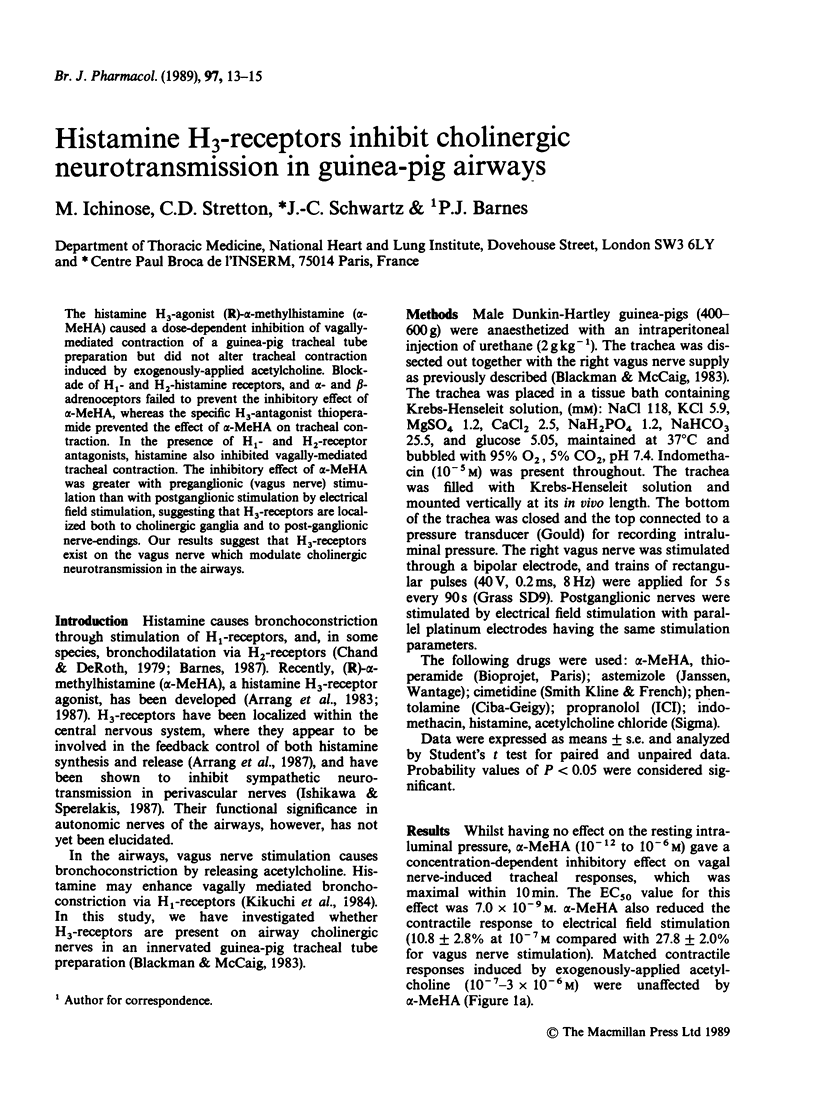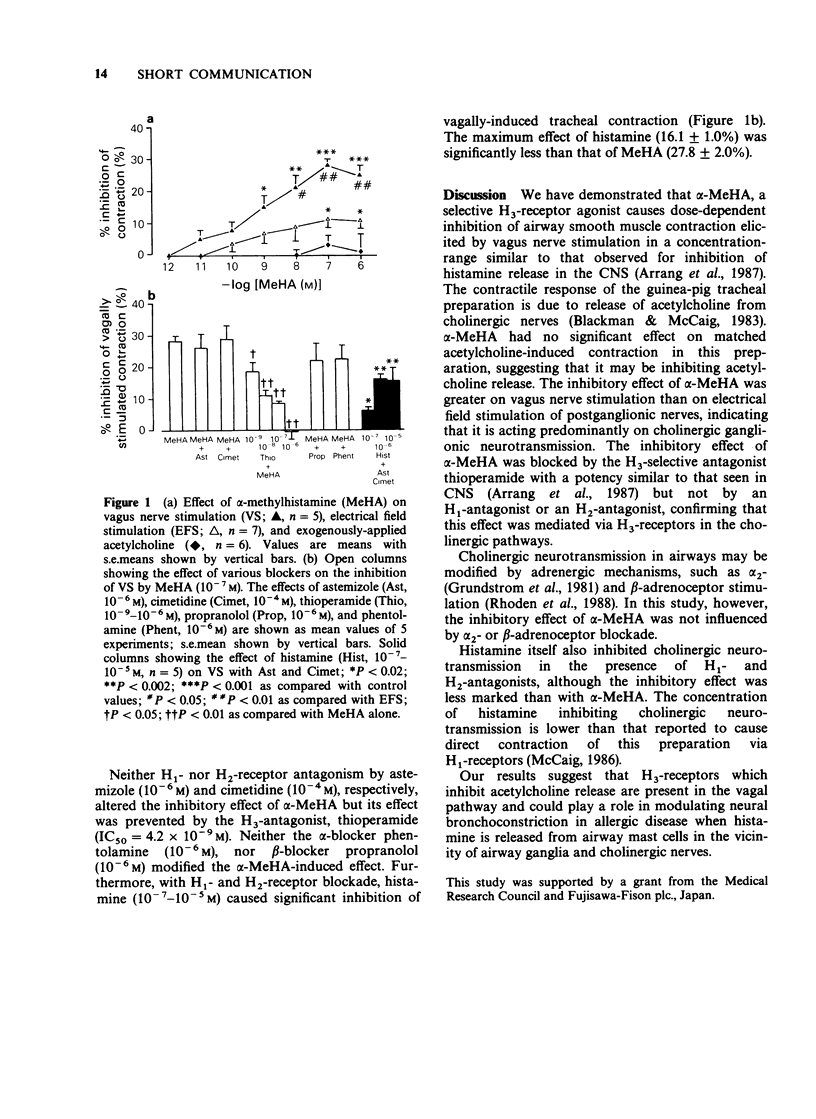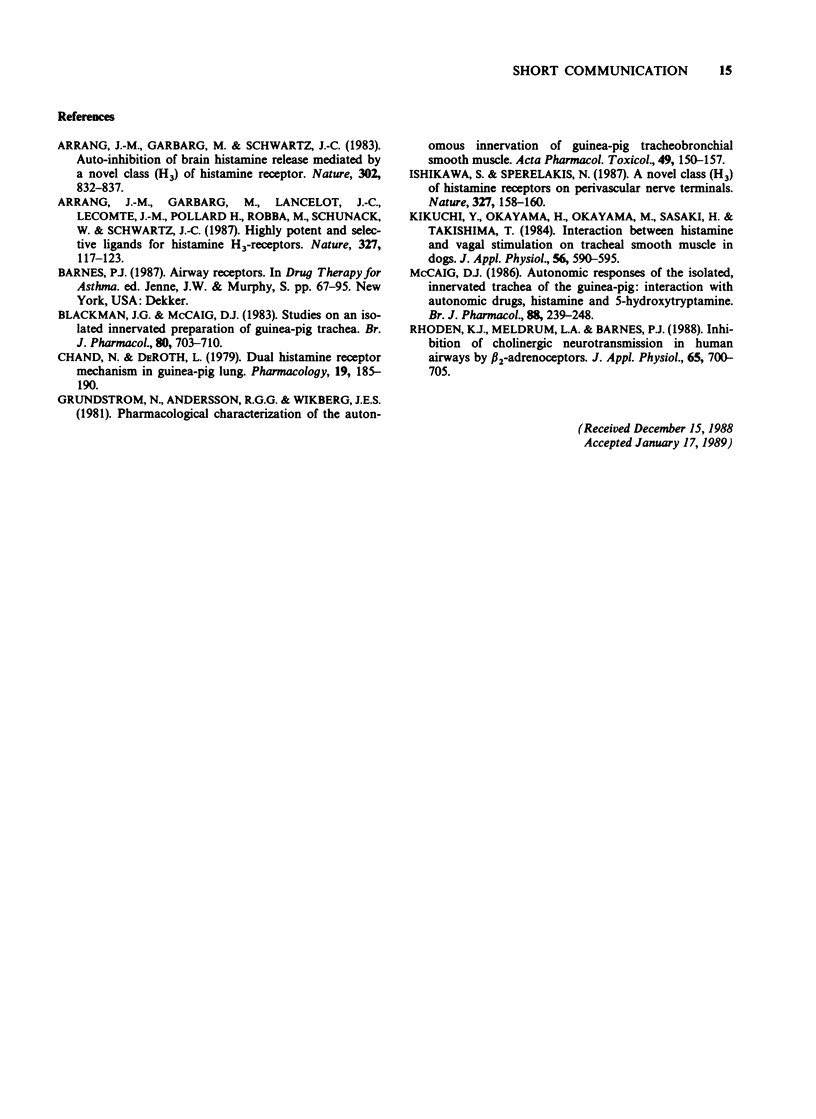Abstract
The histamine H3-agonist (R)-alpha-methylhistamine (alpha-MeHA) caused a dose-dependent inhibition of vagally-mediated contraction of a guinea-pig tracheal tube preparation but did not alter tracheal contraction induced by exogenously-applied acetylcholine. Blockade of H1- and H2-histamine receptors, and alpha- and beta-adrenoceptors failed to prevent the inhibitory effect of alpha-MeHA, whereas the specific H3-antagonist thioperamide prevented the effect of alpha-MeHA on tracheal contraction. In the presence of H1- and H2-receptor antagonists, histamine also inhibited vagally-mediated tracheal contraction. The inhibitory effect of alpha-MeHA was greater with preganglionic (vagus nerve) stimulation than with postganglionic stimulation by electrical field stimulation, suggesting that H3-receptors are localized both to cholinergic ganglia and to post-ganglionic nerve-endings. Our results suggest that H3-receptors exist on the vagus nerve which modulate cholinergic neurotransmission in the airways.
Full text
PDF


Selected References
These references are in PubMed. This may not be the complete list of references from this article.
- Arrang J. M., Garbarg M., Lancelot J. C., Lecomte J. M., Pollard H., Robba M., Schunack W., Schwartz J. C. Highly potent and selective ligands for histamine H3-receptors. Nature. 1987 May 14;327(6118):117–123. doi: 10.1038/327117a0. [DOI] [PubMed] [Google Scholar]
- Arrang J. M., Garbarg M., Schwartz J. C. Auto-inhibition of brain histamine release mediated by a novel class (H3) of histamine receptor. Nature. 1983 Apr 28;302(5911):832–837. doi: 10.1038/302832a0. [DOI] [PubMed] [Google Scholar]
- Blackman J. G., McCaig D. J. Studies on an isolated innervated preparation of guinea-pig trachea. Br J Pharmacol. 1983 Dec;80(4):703–710. doi: 10.1111/j.1476-5381.1983.tb10061.x. [DOI] [PMC free article] [PubMed] [Google Scholar]
- Chand N., DeRoth L. Dual histamine receptor mechanism in guinea-pig lung. Pharmacology. 1979;19(4):185–190. doi: 10.1159/000137308. [DOI] [PubMed] [Google Scholar]
- Grundström N., Andersson R. G., Wikberg J. E. Pharmacological characterization of the autonomous innervation of the guinea pig tracheobronchial smooth muscle. Acta Pharmacol Toxicol (Copenh) 1981 Aug;49(2):150–157. doi: 10.1111/j.1600-0773.1981.tb00884.x. [DOI] [PubMed] [Google Scholar]
- Ishikawa S., Sperelakis N. A novel class (H3) of histamine receptors on perivascular nerve terminals. Nature. 1987 May 14;327(6118):158–160. doi: 10.1038/327158a0. [DOI] [PubMed] [Google Scholar]
- Kikuchi Y., Okayama H., Okayama M., Sasaki H., Takishima T. Interaction between histamine and vagal stimulation on tracheal smooth muscle in dogs. J Appl Physiol Respir Environ Exerc Physiol. 1984 Mar;56(3):590–595. doi: 10.1152/jappl.1984.56.3.590. [DOI] [PubMed] [Google Scholar]
- McCaig D. J. Autonomic responses of the isolated, innervated trachea of the guinea-pig: interaction with autonomic drugs, histamine and 5-hydroxytryptamine. Br J Pharmacol. 1986 May;88(1):239–248. doi: 10.1111/j.1476-5381.1986.tb09492.x. [DOI] [PMC free article] [PubMed] [Google Scholar]
- Rhoden K. J., Meldrum L. A., Barnes P. J. Inhibition of cholinergic neurotransmission in human airways by beta 2-adrenoceptors. J Appl Physiol (1985) 1988 Aug;65(2):700–705. doi: 10.1152/jappl.1988.65.2.700. [DOI] [PubMed] [Google Scholar]


